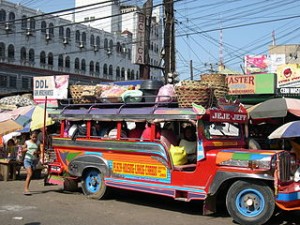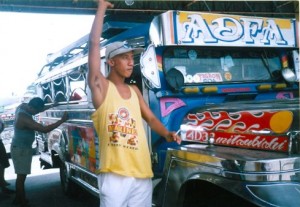
Audience Navigation
Utility Navigation
Student Blogs
Sakay Na
In the few weeks that I have been back in the States, there have already been glaring differences and adjustments back to living in America but none more so than taking public transportation. Public transportation is the beating heart of a city. It helps residents go from point A to point B but it also helps define deeper layers of the city’s character.
As a regular in Manila, I often took Jeepneys aka Jeeps, the staple of public transportation in the Philippines. Modeled after American World War II era jeeps, these vehicles are ubiquitous within the Philippines and are always an eye catcher due to their flamboyantly colored designs. Their interior can consist of massive stereo speakers or live TV depending on the drivers’ funds. Also distinctive in Manila’s city streets are the blaring waves of Jeepney horns. Horns can be customized to sound more bizarre or catchy. Destinations are printed on hand-painted signs hung up in and out of the jeeps. No two jeeps are alike. Their exteriors are decorated with everything from Dragonball Z to national heroes, from Playboy bunnies to religious imagery.
Riding Jeepneys presented its own challenge. Many passengers were on board jeeps daily with customers ranging from students to professionals, rich and poor. Technically, a jeep could fit 18 people but in many cases, many passengers would board no matter what the capacity. Many passengers would hang on the railings on the side and back of the vehicle. “Ghost riding” an action that I once considered to be one of the most dangerous things you could do with a car is a mundane activity for some who ride jeeps.
Also prevalent are “barkers,” men and women who organize the flow of passengers in and out of jeeps. Screaming loudly and emphatically, the barkers allow the endless series of passengers to board the Jeepneys with ease.
In my current state, I find myself taking the D.C. area public transportation system of buses and metro trains. Each bus and train is uniformly colored. Station information is presented in big monitors and announced out loud on PA systems. Each arriving and departing train is synced to the monitors on screen. It goes without saying this has been a far cry from taking Jeepneys on a near daily basis.
Some may consider D.C.’s transportation an upgrade over the “low-tech” Jeepney system in the Philippines, yet I feel nostalgic and miss the Manila system. I miss the cacophony of honking horns and shouting barkers, endless streams of people boarding jeeps, and the vibrant, pastel colors of each Jeep. While they do not offer a technical superiority over public transportation systems in the states, the Jeepney systems offers passengers a sense of humanism. The Jeepney drivers painstakingly create their own individual and beautiful designs of their jeeps. In a way, the Jeeps’ bodywork embodies the drivers’ desires to express themselves through a moving piece of the self, reflective of the time, money, and resources spent to make the Jeeps their own. In many ways this is in keeping with the traditional views of arts and crafts from the ancient traditions of the first Filipinos, the Cordillieras. Many instruments and crafts are decorated with personal touches designed by the owners to self-identify that they are Cordillieras and proud.
In the Philippines, I have found a reverence for tradition that drives the Filipinos to be in sync with ancestral traditions in modern times, one with centuries’ old past and a post-modern present. There is a state of being in which past and present are in harmony with one another. It is the drive for preserving tradition and the humanism that goes into making traditions possible that allow Filipinos to live through adversity in all forms. Sakay na! (Hop on)

Paul Fontelo '13
- Studies: History and music double major
- Hometown: Potomac, Md.
- Alumni
- Read more about Paul »
 Emily Castillo '19
Emily Castillo '19
Former Blogger Gianna DiMaiolo '19
Gianna DiMaiolo '19
Former Blogger Brian Senier '19
Brian Senier '19
Former Blogger Amy Casey '18
Amy Casey '18
Former Blogger Michael DeSantis '18
Michael DeSantis '18
Former Blogger Alexandra Larkin '18
Alexandra Larkin '18
Former Blogger Emily Breakell '17
Emily Breakell '17
Former Blogger Haylie Butler '17
Haylie Butler '17
Former Blogger Ellen Chen '17
Ellen Chen '17
Former Blogger Jessica Vozella '17
Jessica Vozella '17
Former Blogger Caroline Keane '17
Caroline Keane '17
Former Blogger Hildie Hoeschen '17
Hildie Hoeschen '17
Former Blogger Elena Ferguson '17
Elena Ferguson '17
Former Blogger Thomas Vignati '17
Thomas Vignati '17
Former Blogger Holly Nord '16
Holly Nord '16
Former Blogger Ali Olson '17
Ali Olson '17
Former Blogger Jonathan Thompson '17
Jonathan Thompson '17
Former Blogger Bryan Rodriguez '17
Bryan Rodriguez '17
Former Blogger Inez Asante '16
Inez Asante '16
Former Blogger LiAnn Butterfield '16
LiAnn Butterfield '16
Former Blogger Lauren Tilmont '16
Lauren Tilmont '16
Former Blogger Mary Zabinski '13
Mary Zabinski '13
Former Blogger Katharine Shapleigh '13
Katharine Shapleigh '13
Former Blogger Kelsey Horton '13
Kelsey Horton '13
Former Blogger Rosemary Henry '14
Rosemary Henry '14
Former Blogger Kevin Gallagher '13
Kevin Gallagher '13
Former Blogger Vivian Daly '13
Vivian Daly '13
Former Blogger Sarah Rondeau '13
Sarah Rondeau '13
Former Blogger Katie Riley '14
Katie Riley '14
Former Blogger Andrew Retallick '14
Andrew Retallick '14
Former Blogger Connor OBrien '16
Connor OBrien '16
Former Blogger Melissa Nelson '10
Melissa Nelson '10
Former Blogger

